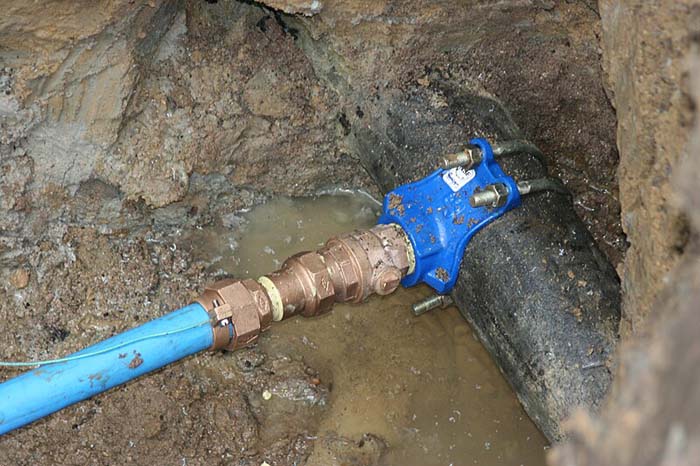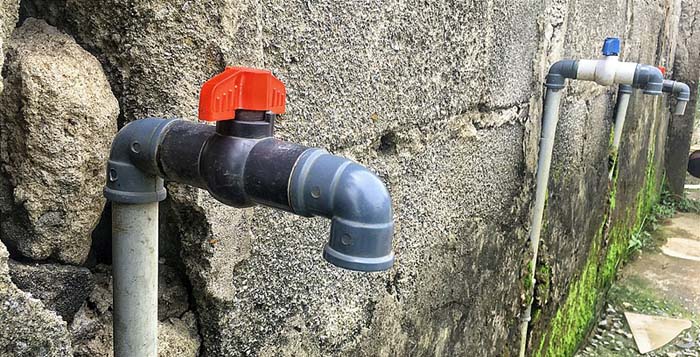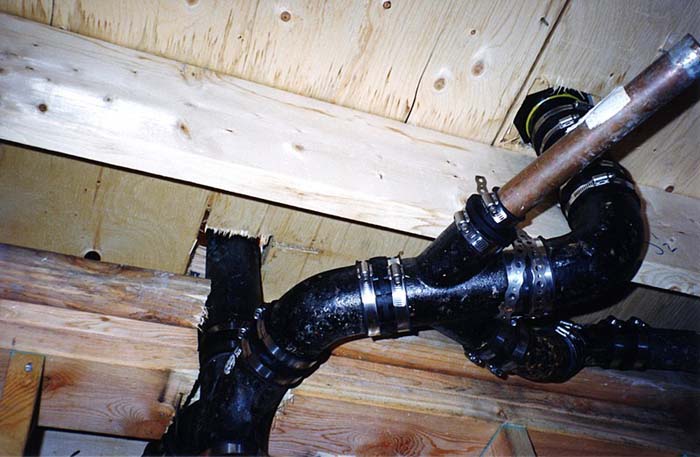
Modern infrastructure would not be complete without plumbing systems. These systems can supply life-sustaining water and other services to homes, businesses, and factories. Various components and functions work together to ensure that gases, water, and waste are transported efficiently and safely.
Here are some common types of plumbing systems:
Plumbing systems are critical in providing buildings with potable water, removing waste, and ensuring adequate drainage. Different plumbing systems are optimized for specific water and waste management infrastructure functions. Here is a summary of the most common types:
- Supply Water Systems
These plumbing systems distribute drinkable water to various points of use in a structure.
- Potable Water System
The system supplies water that is both safe to drink and clean. The water distribution system comprises fixtures, fittings, pipes, and valves that transport water from public or private sources to different areas of a structure.
- Drainage Systems
These pipes and fixtures divert a building’s sewage to an existing private septic tank or sewage system.
- Sanitary Drainage System
It drains sewage from various plumbing fixtures, including showers, toilets, and sinks. It has traps, vents, and drain pipes to ensure proper flow and prevent sewage gases from entering the building.
- Stormwater Drainage System
It handles precipitation discharge from various surfaces, including driveways and roofs. To avoid erosion and flooding, the water is channeled away from the structure into retention basins or storm drains.
- Venting Systems
Preventing sewage gas buildup and maintaining atmospheric pressure in the drainage system are two of the most important functions of venting systems.
- Vent Piping System
Its connection to the drainage system allows air and gases to enter and exit. With the proper venting, sewage can run freely without polluting our air.
- Gas Piping Systems
These plumbing systems supply propane or natural gas for appliances like water heaters and stoves.
natural gas systems, propane systems use propane stored in on-site tanks instead.
- Natural Gas System
Gas is distributed from the main supply line to the building’s gas appliances.
- Propane Gas System
Similar to
- HVAC Systems
These systems use parts that deal with air conditioning, ventilation, and heating.
- Chilled Water System
To produce conditioned air, a component of HVAC systems pumps cold water into cooling coils.
- Hydronic Heating System
This system pumps hot water through a building’s plumbing system. Radiant floor systems, baseboard heaters, or radiators help to circulate hot water or steam.

- Fire suppression systems
These systems provide fire protection by distributing water or other firefighting materials.
- Standpipe Systems
A system of vertical pipes is installed in buildings with multiple stories to supply water to fire hoses.
- Sprinkler Systems
These plumbing systems, installed in both residential and commercial structures, automatically sprinkle water upon detection of a fire.
- Specialty plumbing systems
These plumbing systems help meet the unique needs of certain industries or applications.
- Medical Gas Systems
It helps transport gases such as medical air, nitrous oxide, and oxygen throughout a healthcare facility.
- Irrigation Systems
It is ideal for use in agricultural fields, gardens, and landscapes. This network comprises a system of drip emitters, sprinklers, and pipes.
- Rainwater and greywater harvesting systems
These plumbing systems contribute to water conservation by reusing non-potable water.
- Rainwater Harvesting Systems
Drain and store rainwater for later use, whether for toilet flushing, irrigation, or any number of other applications.
- Greywater Systems
Laundry, showers, and sinks should all have their wastewater collected and treated to reuse it for flushing toilets and irrigation.
Best pipe for home water supply
Several considerations should be made when choosing the ideal pipe for a household water supply, such as local building codes, cost, durability, and installation convenience. The following are some of the most popular pipe materials used in domestic plumbing, along with some brief descriptions of each:
- Galvanized steel pipes
Pros:
- Capable of managing high water pressure.
- Resilient and long-lasting.
Cons:
- Installation is more labor-intensive and costly.
- It is difficult to handle due to its weight and bulk.
- Corrosion and rust can lower the quality of water and cause leaks if left unchecked.
- PEX Pipes
Pros:
- Installation is easier with clamp or crimp connections, and fewer fittings are needed.
- It is typically less expensive than copper.
- Because of its elasticity, PEX is less likely to crack when exposed to subzero temperatures.
- Because of their flexibility, PEX pipes require fewer fittings and joints during installation.
Cons:
- Water pollution may occur if certain varieties of PEX are permeable to specific substances.
- Keep the PEX away from direct sunlight.
- CPVC Pipes
Pros:
- Can withstand harsh chemicals and corrosion.
- CPVC is ideal for cold and hot water applications because it can withstand higher temperatures than standard PVC.
Cons:
- Over time, it might become brittle, particularly when exposed to ultraviolet light.
- It is expensive compared to PVC.
- Copper Pipes
Pros:
- They are recyclable, which makes them eco-friendly.
- Water of varying temperatures won’t affect it.
- You won’t have to worry about them rusting or polluting the water supply.
- Copper pipes are not only long-lasting but also quite durable.
Cons:
- Soldering is required, which can be a labor-intensive process that necessitates the expertise of a plumber.
- Copper pipes are not cheap.
- PVC Pipes
Pros:
- They won’t corrode or rust.
- Simple to set up and operate.
- Low-cost PVC pipes are available.
Cons:
- Some substances may eventually degrade PVC.
- Hot water can cause PVC to distort or even melt.
Recommendations
For Cost-Effectiveness
If money is tight, PVC water lines might be an excellent option; however, you shouldn’t use PVC for hot water.
In areas with extreme heat
The increased temperature tolerance of copper or CPVC makes them ideal candidates for hot water lines.
For new installations
PEX’s resilience to freezing, ease of installation, and flexibility make it a popular recommendation.
Some materials may be recommended or forbidden in specific places. For this reason, it’s important to examine the local regulations and building codes before picking a pipe for your home’s water supply. A licensed plumber is able to provide expert plumbing advice.
Type of plumbing is no longer used?
Using certain formerly popular plumbing materials has caused many problems, and their use in new installations is now discouraged. A few are presented here:
- Copper Pipes (Type M)
- These plumbing systems feature thinner Type K and Type L pipes. This makes them more likely to develop pinhole leaks and reduces their lifespan in specific water conditions. Better alternatives, such as CPVC and PEX, have made Type M less widespread, although it is still used.
- Cast iron pipes
- The vent, waste, and drain lines were constructed from cast iron. It lasts a long time but is heavy, tough to work with, and corrodes easily. ABS or PVC plastic pipes have mostly replaced cast-iron pipes in contemporary plumbing systems.
- Galvanized steel pipes
- The plumbing systems were in high demand right up to the ’60s. Over time, they deteriorate, which decreases water flow and makes leaks more likely. Plumbing renovations frequently involve the replacement of galvanized steel pipes with plastic or copper pipes.
- Orangeburg Pipes
- Sewer lines used pipes made of bituminized fiber, which combined pitch and wood pulp. Their vulnerability to tree root intrusion and collapse is high. More dependable materials like ABS and PVC have replaced Orangeburg pipes.
- Lead Pipes
- The widespread use of lead pipes in the early 20th century was linked to significant health risks. This is the result of lead leaching into drinking water. Pipes made of lead are gradually phased out and replaced in older structures.
- Polybutylene Pipes:
- Despite their widespread use from the 1970s through the 1990s, they eventually break or become extremely brittle when exposed to water additives such as chlorine. Pipes made of polybutylene are no longer produced or used. Most of the time, long-lasting materials such as CPVC or PEX replace the existing pipes.
What type of plumbing is used now?
The materials used in modern plumbing systems are carefully chosen for their unique properties, intended use, and specific building needs. Today, the most commonly used materials in plumbing systems are:
- Cast Iron
- Heavy and long-lasting cast iron does a great job of reducing noise. Its noise-reduction qualities make it a popular choice for DWV systems in commercial plumbing systems.
- Galvanized Steel
- Resilient and long-lasting. It has long been used in outdoor plumbing and water supply systems. Unfortunately, its reduced water flow and corrosion resistance over time have made it less popular in modern times.
- CPVC
- These are protected from chemical damage and corrosion. They are also capable of withstanding higher temperatures than standard PVC. It is an ideal domestic supply line for both cold and hot water.
- PVC
- These plumbing systems are chemical and corrosion-resistant, easy to work with, and lightweight. This method is commonly used in waste, vent, and drainage systems. Avoid installing this method on pipes that supply hot water.
- Stainless Steel
- Aesthetically appealing, corrosion-resistant, and very durable. Commercial and residential water supply lines use this material, particularly in areas vulnerable to corrosion.
- PEX
- These systems exhibit superior resistance to cold conditions compared to others, feature a simple installation process, are resistant to chlorine and scale, are flexible, and do not develop pinholes or corrosion. They are ideal for application in both commercial and residential plumbing systems. This includes radiant floor heating systems and hot and cold water supply lines.
- Copper
- These can withstand high pressures and temperatures, resist bacteria, and be long-lasting. Copper is useful for both cold and hot water supply lines. It can be found in older houses and places where safety and durability are a priority.
Different materials have different applications depending on budget, plumbing system specifications, and local building codes. For home applications, for instance, CPVC and PEX are common because they are inexpensive and easy to install. However, copper is commonly chosen because it is reliable and long-lasting, even if it is more expensive.
What plumbing lasts the longest?
It is commonly believed that the following plumbing materials will last the longest:
Cast Iron Pipes
Cast iron pipes’ long lifespan—75 to 100 years or longer—makes them ideal for drainage systems. Their resistance to noise and abrasion also makes them excellent choices for some uses.

PEX Pipes
Compared to metal pipes, PEX pipes have many advantages, such as being easier to work with, less likely to develop pinholes or corrode, and more flexible. They are also resistant to chlorine and scale. These plumbing systems have a long lifespan of more than fifty years, making them a dependable and long-lasting option for numerous uses.
Stainless Steel Pipes
Stainless steel pipes have a long lifespan (typically more than fifty years) and are very corrosion-resistant. They are typically used in areas where corrosion is a major concern. Additionally, although they are usually more expensive, they are extremely long-lasting.
PVC Pipes
Drain, waste, and vent lines are commonly made with PVC pipes since they are long-lasting and chemically resistant. Under ideal circumstances, PVC pipes can endure forever; nonetheless, prolonged exposure to sunlight might reduce their durability.
Galvanized Steel Pipes
Because of their susceptibility to corrosion and clogging, these pipes are no longer widely utilized as water supply lines. With the right care, though, they have a 20- to 50-year lifespan.
Copper Pipes
For a long time, copper’s resistance to corrosion and general durability made it the material of choice for plumbing. Although it can endure longer in perfect circumstances, its typical lifespan is 50 to 70 years. Additionally, copper is safe to consume and has excellent microbial resistance.
CPVC Pipes
It is common practice to use CPVC, which is similar to PVC but has chlorine added to withstand higher temperatures, for the distribution of cold and hot water. Because of its resistance to chemicals and corrosion, CPVC can withstand harsh environments for 50 to 75 years.
Cast iron, PEX, and copper are the three most durable plumbing materials. However, their relative qualities will vary with the conditions and needs of any given system.
Pipe that is not recommended for a water line
Some pipes should not be used for water supply lines because regulations restrict them, they need to be more durable, or they pose health risks. Examples of pipes that are not suitable for use as water lines include:
- ABS Pipes
- Most plumbing rules do not permit the use of ABS pipes for drinking water lines. These pipes are only used as vents, waste, and drains; they are not intended to supply water.
- Galvanized steel pipes
- Rust and corrosion can form on these pipes, leading to a clogged system and perhaps contaminated water. Although they were once common, modern building practices typically avoid them and replace them with older systems.
- PVC Pipes
- PVC pipes can withstand cold water without deterioration or warping, but they shouldn’t be used for hot water lines. Hot water pipes should instead be made of CPVC.
- Polybutylene Pipes
- Chemical interactions with chlorine in the water supply can cause PB pipes, widely employed from the 70s to the 90s, to collapse. They are frequently replaced because of how often they fail and leak; thus, they are no longer utilized.
- Lead Pipes
- Serious health problems, particularly in children, can result from lead leaching into the water supply. Lead pipes for drinking water are illegal, according to most building codes.
Conclusion
CPVC, PEX, and copper are commonly suggested materials for water supply lines because of their safety, longevity, and ability to meet plumbing requirements. Before installing any pipe, check with your city or county to be sure it can handle potable water and meets all construction codes.
